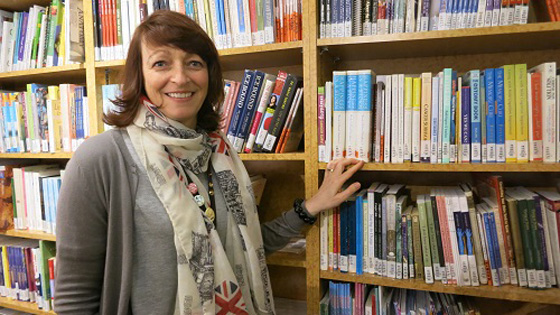
Michelle Snow, Patient & Family Librarian at Princess Margaret Cancer Centre, helps patients and families find the resources they need to better manage their disease. (Photo: UHN)
Michelle Snow knows first-hand how low health literacy can affect patient care.
"A patient recently walked into the Library and was having trouble finding treatment information. She didn't speak English and was visibly frustrated and overwhelmed," says Michelle, Patient & Family Librarian at Princess Margaret Cancer Centre.
"I worked with her to find the eight or nine resources she needed, in the language she needed them in. She must have shaken my hand five times with appreciation."
October is
Health Literacy Month, which describes a person's ability to obtain, understand and act upon health information. This includes everything from being able to interpret a medication label to take it correctly, and knowing how to read and follow treatment schedules.
A patient's health literacy: A matter of 'life and death'
A person's health literacy level can be shaped by things like language fluency, education level and their general knowledge of health practices.
Sixty per cent of Canadians have low health literacy – meaning they struggle to obtain and understand basic health information. Research shows that patients with low health literacy are more likely to detect chronic disease later, fail to adhere to treatment regimens, and have poorer health outcomes.
This means the vast majority of UHN patients and families require additional education or support to navigate and use the healthcare system effectively. A patient's health literacy level is truly a matter of life and death.
Below are three ways you can support patients and families with low health literacy:
1. Send your patients to UHN's Patient & Family Libraries
The Princess Margaret, Toronto General Hospital, Toronto Western Hospital and Toronto Rehab all have
patient and family libraries.
Trained librarians help library-goers search a catalogue of over 900 pamphlets, audio CDs, eBooks and more to find the specific information they need. No one leaves the library empty-handed.
2. Every patient learns differently – offer materials tailored to diverse audiences
The UHN Patient & Family Education Program works with each UHN site to develop multi-modal education resources that are easy for patients and families to understand and use.
Work with your local Patient & Family Education Program to develop patient education classes, pamphlets, videos, eLearning or website content.
To work with the Program or get more tools and resources on health literacy to enhance your daily practice, visit the Program
website.
3. Assume all patients may have difficulty understanding health information
Use a "universal precautions" approach to reduce "never events," which The Canadian Patient Safety Institute describes as "patient safety incidents that result in serious patient harm or death, and can be prevented by using organizational checks and balances."
Health literacy universal precautions are the measures healthcare professionals take when they assume all patients may have difficulty understanding health information.
This includes:
- Presenting health information in plain, everyday language without medical jargon
- Making hospitals and clinics easier for patients to get around in
- Providing accessible, multi-modal patient education tailored to the diverse ways patients learn
- Making sure patients who are not comfortable communicating in English have access to
medical interpreters
"With an increasing emphasis on outpatient care models and patient self-management, health literacy universal precautions become an evidence-based approach to mitigate the effects of low health literacy, and empower patients to better manage their care," says Janet Papadakos, Manager of the Princess Margaret's Patient & Family Education Program.
By always providing health education that responds to the lowest possible health literacy level, we can ensure that no patients and families are left behind.
